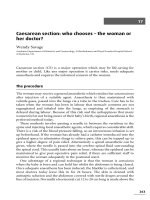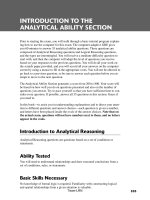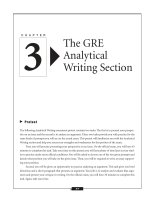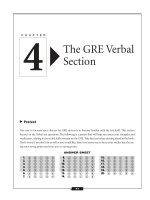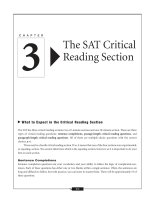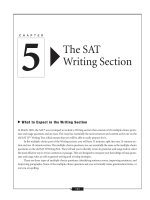The Multiple-Choice Section
Bạn đang xem bản rút gọn của tài liệu. Xem và tải ngay bản đầy đủ của tài liệu tại đây (239.78 KB, 44 trang )
A
s with the SAT as a whole, most of the questions in the Writing section are multiple choice. That
means for each question, the correct answer is provided for you—but so are four incorrect ones.
The ETS is masterful at creating tricky distracters—wrong answers designed to look like possible
correct answers. It’s your job to weed out the wrong answers and select the right one. While there are specific strate-
gies for finding the right answer for each type of multiple-choice question, there are some basic rules that work
for all of them:
■
Read the question carefully. Be sure you know exactly what is being asked. In particular, look for tricky
wording such as, “All of the following are true about the author’s purpose EXCEPT.” Train yourself to
notice any word in the question that is in all capital letters. Such a word will often completely change the
meaning of the question.
■
Rule out incorrect answers. You may only be able to eliminate one or two incorrect answers, but every
elimination increases the probability that you will choose the correct answer. Mark up your test booklet,
putting a line through each answer as it is eliminated to avoid confusion.
CHAPTER
The Multiple-
Choice Section
2
11
■
Remember the rule for guessing. If you can’t
eliminate one answer, skip it. If you can eliminate
one or more, guess, and move on.
■
Beware of distracter techniques. While dis-
tracters, or traps designed to lure you away from
the right answer, are more prevalent in the Criti-
cal Reading and Math sections of the SAT, they do
appear in a more subtle form in the Writing sec-
tion. You won’t find those absolute words, such as
always, never, all, and none. But you will
encounter, especially with more difficult ques-
tions, answers that at first glance appear correct.
For the easier questions, the answer probably is
right, but for the difficult ones, think twice. We’ll
get more specific about distracters as we explore
each type of multiple-choice question in depth.
These are the three types of multiple-choice ques-
tions you’ll encounter in the Writing section:
■
Identifying Sentence Errors
Each sentence has four underlined words or
phrases, and a fifth choice, “no error.” You need to
determine which underlined portion, if any, con-
tains an error in grammar or usage. If the sen-
tence is correct, you will choose answer e,“no
error.” Approximately 25% of the multiple-choice
writing questions are this type.
■
Improving Sentences
You’ll be given five versions of a sentence, and
have to choose the one that is most clear and cor-
rect. Approximately 65% of the questions in the
Writing section are Improving Sentences.
■
Improving Paragraphs
These questions concern a passage of approxi-
mately 200 words. They ask about how to
improve the passage on many levels, from large-
scale organizational issues to word choice and
grammar. Approximately 10% of the questions
are this type.
Identifying Sentence Errors
These multiple-choice questions are designed to test
your knowledge of grammar and usage. Let’s take a
closer look at how they are structured, the types of
errors you’re most likely to encounter, and how best to
approach Identifying Sentence Errors. At the end of this
section, we’ve included ten practice questions (answers
are at the end of the chapter).
Question Structure
Each sentence has four possible errors, underlined and
marked a–d. There is also a choice e for “no error.” No
sentence contains more than one error. It is your task
to find the error, or choose e if the sentence is correct.
You are not asked to identify, explain, or correct it. All
you must do is locate it.
Here’s a sample:
Those old Atari video games in your closet ar
e on the
a
wish list of the Computer Museum of America, in
S
an Diego, California, and they hope you will donate
bc
it to their holding
s.No error.
de
What’s wrong? The plural verb are is correct; it
expresses the action of the plural noun games.There’s
also nothing wrong with San Diego, California and
holdings. The plural pronoun they, however, is incor-
rect. It replaces the noun Computer Museum of Amer-
ica, which is singular.
Errors You’re Likely to See
There are many possible grammar and usage errors,
and of course, every type is fair game. However, most
of the questions will contain just a handful of common
errors. In this section, we’ll review the eight you’re
most likely to encounter. When you know what to look
for, you’ll find sentence errors more easily.
–
THE MULTIPLE-CHOICE SECTION
–
12
Grammar and Usage
The grammar and usage issues you’ll most often encounter are:
■
agreement
■
consistency
■
parallel structure
■
verb form
13
We began this chapter with Identifying Sentence
Errors for one important reason: Many of the gram-
mar and usage issues prevalent in these questions will
also come up in Improving Sentences and Improving
Paragraphs questions. If the review that follows isn’t
enough for you to fully understand each possible error,
study those you still find confusing at greater length
with a grammar book such as Goof-Proof Grammar
(LearningExpress, 2002).
Agreement
Expect at least one of your Improving Sentence Errors
questions to be about agreement, meaning the balance
of sentence elements such as subjects and verbs and
pronouns and antecedents. (Recall that an antecedent
is the noun that a pronoun replaces.) To agree, singu-
lar subjects require singular verbs, and plural subjects
require plural verbs. Likewise, singular nouns can be
replaced only by singular pronouns, and plural nouns
require plural pronouns.
To make this type of question tricky, you’ll often
find a “filler” phrase between the subject and verb or
noun and pronoun. The intention is to distract you; the
more space between the subject and verb or noun and
pronoun, the more difficult it can be to determine
agreement.
Here’s an example:
“Eat, drink, and be merry,” is a lab
el associated with
ab
Greek philosopher Epicurus, but like most catchy
slogans, the
y simplify what is actually a rich and
cd
complex message. N
o error.
e
Notice how the phrase like most catchy slogans
can mislead you. If you assume slogans is the subject,
then the pronoun they and the verb simplify seem
correct—they agree with the plural subject. But subjects
are never in prepositional phrases, so slogans can’t be
the subject of the verb simplify. Look again at the sen-
tence. What is simplifying? Not the slogans, but the
label “Eat, drink, and be merry”—a singular noun.
Thus, the pronoun must be it and the verb must be sim-
plifies to agree with the subject, so choice c contains the
error and is therefore the correct answer.
■
pronoun case
■
idiom
■
word choice
■
adjectives and adverbs
Consistency
Just as sentences must be balanced, they must also be
consistent. And like errors in agreement, errors in con-
sistency involve verb and pronoun usage. For example,
if a sentence begins in the past tense, it must stay in the
past tense. Pronouns need to be consistent in person
and number. A shift from the singular I to the plural we,
for example, can leave the reader wondering just who
is doing what in the sentence.
Here are two examples of errors in consistency
from the practice tests:
Keeping your room unc
luttered is easy when you
a
mak
e it a habit t
o spend ten minutes a day just
bc
putting things back where they b
elonged.No error.
de
Think twice before sending p
otentially computer-
a
clogging e-mail
attachments such as pictures and
b
videos; if the recipient is lo
w on disk space, or uses a
c
dial-up service to get the
ir e-mail, he or she won’t
d
appreciate the gesture. N
o error.
e
The first sentence is in the present tense as evi-
denced by the present participles keeping and putting, and
the present make. But it ends with the past tense belonged.
To be consistent, that last verb needs to be changed to the
present tense belong. In the second sentence, the author
correctly uses the singular pronoun he or she to replace
the singular noun recipient. But she then incorrectly uses
the plural pronoun their to refer to the same antecedent.
The use of his or her would correct the error.
Parallel Structure
Parallel structure involves pairs and lists of words and
phrases. Both items in a pair, and all items in a list
need to follow the same grammatical pattern. If you’re
writing about your friend’s favorite leisure activities,
you wouldn’t say, “Juan loves skating and to read.” It
sounds awkward because the items in the pair aren’t the
same grammatically. The first is a participle (skating),
and the second is an infinitive (to read). Even if the
names of the verb tenses aren’t familiar to you, you can
see that one of the two needs to be changed in order to
maintain parallel structure. You could change skating
to to skate,or to read to reading. Either way, you’ll get
parallel structure.
Here, again, are examples from the practice tests:
One o
f the best ways to prepare for a career in
a
journalism is to become an inf
ormed citizen by
b
reading a variety of newspapers, watching
documentaries and t
elevised news programs, and
c
y
ou should read
books about world leaders, politics,
d
and grassroots movements. N
o error.
e
This sentence offers a list of three things one can
do to become an informed citizen: reading, watching,
and you should read. Notice how the third item does not
follow the same grammatical pattern as the first. It
should begin with a verb in participial form, reading.
You should is unnecessary and should be eliminated.
The more I r
ead about deep sea fishing, the more
ab
it mak
es me want to get out there and try it. No error.
cde
In this example, the phrases after the words the
more I read are not grammatical equivalents. It makes
me should be matched with I want to.
–
THE MULTIPLE-CHOICE SECTION
–
14
Verb Form
Verbs are the “meat” of a sentence—they express what
the subject is doing, thinking, or feeling. Correct verb
form is essential to sentence clarity, and you can expect
to find at least one question with a verb form issue.
Here are some of the common verb errors found on
the SAT.
■
Incorrectly conjugated irregular verbs. About
150 English verbs are irregular; that is, they do
not follow the standard rules for changing tense.
We can divide these irregular verbs into three
categories:
irregular verbs with the same past and past par-
ticiple forms
irregular verbs with three distinct forms
irregular verbs with the same present and past
participle forms
The following table lists the most common irreg-
ular verbs.
–
THE MULTIPLE-CHOICE SECTION
–
15
PRESENT PAST PAST PARTICIPLE
SAME PAST AND PAST PARTICIPLE FORMS:
bite bit bit
dig dug dug
bleed bled bled
hear heard heard
hold held held
light lit lit
meet met met
pay paid paid
say said said
sell sold sold
tell told told
shine shone shone
shoot shot shot
sit sat sat
spin spun spun
spit spat spat
swear swore swore
tear tore tore
creep crept crept
PRESENT PAST PAST PARTICIPLE
deal dealt dealt
keep kept kept
kneel knelt knelt
leave left left
mean meant meant
send sent sent
sleep slept slept
spend spent spent
bring brought brought
buy bought bought
catch caught caught
fight fought fought
teach taught taught
think thought thought
feed fed fed
flee fled fled
find found found
grind ground ground
THREE DISTINCT FORMS:
begin began begun
ring rang rung
sing sang sung
spring sprang sprung
swim swam swum
do did done
go went gone
am was been
is was been
–
THE MULTIPLE-CHOICE SECTION
–
16
PRESENT PAST PAST PARTICIPLE
see saw seen
drink drank drunk
shrink shrank shrunk
sink sank sunk
stink stank stunk
swear swore sworn
tear tore torn
wear wore worn
blow blew blown
draw drew drawn
fly flew flown
grow grew grown
know knew known
throw threw thrown
drive drove driven
strive strove striven
choose chose chosen
rise rose risen
break broke broken
speak spoke spoken
fall fell fallen
shake shook shaken
take took taken
forget forgot forgotten
get got gotten
give gave given
forgive forgave forgiven
forsake forsook forsaken
–
THE MULTIPLE-CHOICE SECTION
–
17
–
THE MULTIPLE-CHOICE SECTION
–
18
PRESENT PAST PAST PARTICIPLE
hide hid hidden
ride rode ridden
write wrote written
freeze froze frozen
steal stole stolen
SAME PRESENT AND PAST PARTICIPLE FORMS:
come came come
overcome overcame overcome
run ran run
In English, as in many other languages, the essential verb to be is highly irregular:
SUBJECT PRESENT PAST PAST PARTICIPLE
I am was have been
you are were have been
he, she, it is was has been
we are were have been
they are were have been
Here’s an example of an irregular verb question:
Eliza laid
down on her bed to rest while the rest of
abc
her family enjoyed the ap
petizing meal prepared by
d
her grandmother. N
o error.
e
Lay and lie are commonly confused. To lay means
to place something down, and to lie means to recline.
Obviously in this sentence, the latter verb is required;
however, to make things even more confusing, the cor-
rect past tense form of to lie is lay.
■
Incorrect tense. If there’s an error in tense, the
sentence will provide enough context for you to
determine the tense the verb(s) should be in. For
example:
From 1947 to 1956, thousands of scrolls and
fragments of ancient manuscripts has b
een found in
a
caves on the sho
re of the Dead Sea, inc
luding early
bc
copies of biblical b
o
oks in Hebrew and Aramaic.
d
N
o error.
e
Has been is the present perfect form of the verb is.
However, the first phrase, From 1947 to 1956, tells us
that the action took place in the past. This sentence
requires the simple past tense, were.
■
Missing subjunctive. Most verbs are in the
indicative mood, meaning that they simply indi-
cate an action, thought, or feeling. The subjunc-
tive mood is used to express something that is
wished for or that is untrue. It is formed with the
past tense or past perfect tense (using the helping
verb were). But we often forget to use it, both in
speech and in writing. When a sentence starts
with if, I wish,or It would have been, it’s probably
in the subjunctive mood.
It w
ould have been nice if you brought more money
ab
with you because these
tickets are very expensive.
cd
N
o error.
e
The clause it would have been tells us that the
money isn’t there, it’s just wished for, so the verb needs
to be subjunctive: if you had brought.
Pronoun Case
Personal pronouns have two main forms: the subjective
and objective cases. This simply means that we use one
form when the pronoun is acting as a subject and
another form when the pronoun is acting as an object.
Expect to see a couple of sentence errors involving con-
fusion of subjective and objective cases.
PERSONAL PRONOUNS
SUBJECTIVE OBJECTIVE
CASE CASE
Ime
you you
he, she, it him, her, it
we us
they them
who whom
Here’s an example that uses a distracter:
The difference between y
ou and me is that you get
ab
your best work done in the morning w
hile I
c
p
erform better in the evening. No error.
de
You and me is not the subject of the sentence (dif-
ference is), but rather the object of the preposition
between. Even if it might sound wrong, me, the objec-
tive form of I, is correct.
Another common sentence error involves a pro-
noun following the word than. Because the than +
(pro)noun construction requires a verb (even if that
verb is not articulated), you must use the subjective
form of the pronoun: I am taller than he [is].
–
THE MULTIPLE-CHOICE SECTION
–
19
You’ll probably find at least one multiple-choice
question that tests your ability to differentiate between
who and whom. Who is the subjective form, and whom
is the objective. If you’re unclear about which to use,
substitute the words he and him for who or whom.Ifhe
is correct, you need who (both subjective case) and if
him is correct, you need whom (both objective case).
Here’s an example:
The physical and psychological unr
est of the working
a
class was e
xplored often in the plays of Arthur Miller,
b
for w
ho the subject of the American Dream, and its
c
a
chievability for ordinary Americans, never got stale.
d
N
o error.
e
Who is the object of the preposition for, but it is
in the subjective case. Correct it by changing it to the
objective form whom. If you were unclear about
whether this was the error, you could have recast the
sentence to try he or him in place of who:
The subject of the American Dream never got
stale for (he/him).
Obviously, him is correct.
Idiom
Idioms are expressions peculiar to a particular lan-
guage, whose meanings cannot be discerned by defin-
ing them word for word. What downward movement,
for example, happens when one “falls in love”? On
what is one perched on when “sitting pretty”? There are
thousands of English idioms, most of which are very
familiar to you, even though you may not have known
they were idioms. The two most common errors you’re
likely to encounter are those involving prepositional
pairs (e.g., take care of, according to) and the use of
infinitives and gerunds (e.g., want to meet,practice
swimming).
Since idioms are typically learned through con-
versation, you’ll probably be able to hear idiom errors
in the Identifying Sentence Errors multiple-choice
questions. Listen carefully to each sentence as you read
it, and identify the error.
1. This year’s model is different than last year’s.
2. She has difficulty in the Advanced Placement
History class.
3. The color choices are typical for that artist.
These errors should have sounded wrong to you:
(1) different than should be different from, (2) difficulty
in should be difficulty with, (3) typical for should be
typical of. If the subject of prepositions is confusing,
you’ll need to do some memorizing. Idioms are
idiosyncratic—there are no easy rules for remembering
them! Following is a list of idiomatic preposition uses
that often appear on the SAT.
–
THE MULTIPLE-CHOICE SECTION
–
20
agree on an amendment
agree to do something
agree with someone
argue about or for a proposal
argue with a person
apologize for an error
approve of a change
bored with small talk
compare to (when you are showing the likes of
two things or putting them in same cate-
gory)
compare with (when highlighting similarities or
differences)
concerned about or with an issue
contrast with (when noting differences)
correspond to or with something (meaning to
relate)
correspond with a person (meaning to
communicate)
differ from something
independent of someone or something
interested in a subject
interfere in someone’s business
interfere with an activity
similar to something
stand by or with someone
stand for a cause
stand on an issue
succeed in an endeavor
wait at a place
wait by the phone
wait for someone
wait in the snowstorm
wait on a customer
work with
me
–
THE MULTIPLE-CHOICE SECTION
–
21
The other type of idiom error you’re likely to see
is the improper use of infinitives (to + verb: to water)
and gerunds (verb + ing: watering). Some verbs must
take one or the other, and a small handful take both.
Your ear will probably hear this type of error. Listen for
the non-idiomatic usages in the following sentences:
1. I spend two hours each day practicing to swim.
2. We had fun pretending being rock stars.
3. My father resents to be asked for money all the
time.
Here are the errors you should have heard: (1)
practicing to swim should be practicing swimming, (2)
pretending being should be pretending to be, and (3)
resents to be should be resents being. As with preposi-
tions, if you’re confused about when to use gerunds and
infinitives, you’ll need to do some memorizing.
VERBS THAT TAKE
VERBS THAT VERBS THAT EITHER INFINITIVES
TAKE INFINITIVES TAKE GERUNDS OR GERUNDS
afford admit attempt
agree adore begin
aim appreciate bother
ask avoid cannot bear
appear consider cannot stand
–
THE MULTIPLE-CHOICE SECTION
–
22
VERBS THAT TAKE
VERBS THAT VERBS THAT EITHER INFINITIVES
TAKE INFINITIVES TAKE GERUNDS OR GERUNDS
be determined deny cease
beg detest continue
care discuss hate
claim dislike hesitate
decide enjoy intend
expect escape like
have finish love
hope imagine prefer
learn keep start
manage mind
mean miss
need postpone
offer practice
plan put off
pretend quit
promise recall
refuse recollect
say resent
tend resist
try risk
wait suggest
want tolerate
wish understand
Word Choice
Many students breathed a sigh of relief when the Col-
lege Board announced that it was dropping Analogy
questions from the SAT. These questions appraised
vocabulary, and were thought to be among the hardest
on the test. However, they’ve been replaced by a hand-
ful of Identifying Sentence Errors questions involving
word choice. Here’s where you’ll need to show you
know the difference between affect and effect, whether
or weather, and fewer and less.
There are two categories of words that are most
problematic: confused words (homonyms that sound
the same but have different meanings and spellings)
and misused words (pairs so often used incorrectly
the errors sound acceptable to most people). Read
through the lists of some of the most frequently tested
words, noting any you’re not sure of.
–
THE MULTIPLE-CHOICE SECTION
–
23
CONFUSED WORDS
WORD DEFINITION
a lot (noun) many
allot (verb) to give or share in arbitrary amounts
accept (verb) to recognize
except (prep.) excluding
access (noun, verb) means of approaching; to approach
excess (noun, adj.) extra
addition (noun) increase
edition (noun) an issue of a book or newspaper
advice (noun) a recommended opinion
advise (verb) to give advice; inform
affect (verb) to influence
effect (noun) result
effect (verb) to bring about
all ready (adj.) completely prepared
already (adv.) by or before a specified or implied time
all together (adj.) in a group; in unison
altogether (adv.) completely or thoroughly
CONFUSED WORDS
WORD DEFINITION
allude (verb) to refer to something not specifically mentioned
elude (verb) to escape notice or detection
ascent (noun) the act of climbing or rising
assent (verb) to agree or accept a proposal or opinion
assure (verb) to make certain (assure someone)
ensure (verb) to make certain
insure (verb) to secure from harm; to secure life or property in case of loss
beside (adj.) next to
besides (adv.) in addition to
bibliography (noun) list of writings
biography (noun) a life story
capital (noun) money invested; a town or city where the government sits
capitol (noun) a government building
choose (verb) to select
chose (verb) the past tense of choose
cite (verb) to acknowledge; to quote as a reference
sight (noun) the ability to see; vision
site (noun) a place or location
complement (noun) match
compliment (noun, verb) praise; to give praise
consul (noun) an official appointed by the government to live in a foreign city and
attend to the interests of the official’s country
council (noun) a group of people called together to provide advice
counsel (noun, verb) advice; to give advice
continual (adj.) taking place in close succession
continuous (adj.) without break or let up
–
THE MULTIPLE-CHOICE SECTION
–
24
CONFUSED WORDS
WORD DEFINITION
cooperation (noun) assistance; help
corporation (noun) type of business organization
decent (adj.) well mannered
descent (noun) decline; fall
dissent (noun) disagreement
desert (noun) arid, sandy region
dessert (noun) sweet served after a meal
disburse (verb) to pay
disperse (verb) to spread out
disinterested (adj.) impartial; no strong opinion either way
uninterested (adj.) don’t care
elicit (verb) to stir up
illicit (adj.) illegal
envelop (verb) to surround; to cover completely
envelope (noun) flat paper container for letters or other documents
farther (adv.) beyond
further (adj.) additional
flack (noun, verb) press agent (noun); to act as a press agent (verb)
flak (noun) criticism
forth (adv.) forward; onward
fourth (adj.) next in number after the third
hear (verb) to perceive by the ear
here (adv.) in this or at this place
hoard (verb) to collect and keep
horde (noun) a huge crowd
imply (verb) to hint or suggest
infer (verb) to assume; to deduce
–
THE MULTIPLE-CHOICE SECTION
–
25
CONFUSED WORDS
WORD DEFINITION
loose (adj.) not restrained; not fastened
lose (verb) to fail to win; to be deprived of
loath (adj.) reluctant
loathe (verb) to feel hatred for
medal (noun) a badge of honor
meddle (verb) to interfere
metal (noun) a mineral substance
passed (verb) the past tense of past
past (adj.) finished; gone by
personal (adj.) individual
personnel (noun) employees
principal (adj.) main
principal (noun) person in charge
principle (noun) standard
quiet (adj.) still; calm
quit (verb) to stop; to discontinue
quite (adv.) very; fairly; positively
stationary (adj.) not moving
stationery (noun) writing paper
taught (verb) the past tense of teach
taut (adj.) tight
than (conj., prep.) in contrast to
then (adv.) next
their (pronoun) belonging to them
there (adv.) in a place
they’re contraction for they are
–
THE MULTIPLE-CHOICE SECTION
–
26
CONFUSED WORDS
WORD DEFINITION
to (prep.) in the direction of
too (adv.) also; excessively
two (adj.) the number after one
weather (noun, verb) atmospheric conditions; to last or ride out
whether (conj.) if it be the case; in either case
who (pronoun) substitute for he, she, or they
whom (pronoun) substitute for him, her, or them
your (pronoun) belonging to you
you’re contraction for you are
–
THE MULTIPLE-CHOICE SECTION
–
27
MISUSED WORDS
WORD WHEN TO USE IT
allude used when a reference is made indirectly or covertly
refer used when something is named or otherwise mentioned directly
amount used when you cannot count the items to which you are referring, and
when referring to singular nouns
number used when you can count the items to which you are referring, and
when referring to plural nouns
anxious nervous
eager enthusiastic, or looking forward to something
among used when comparing or referring to three or more people or things
between used for two people or things
bring moving something toward the speaker
take moving something away from the speaker
Hint: Remember, you bring to, and you take away.
can used to state ability
may used to state permission

